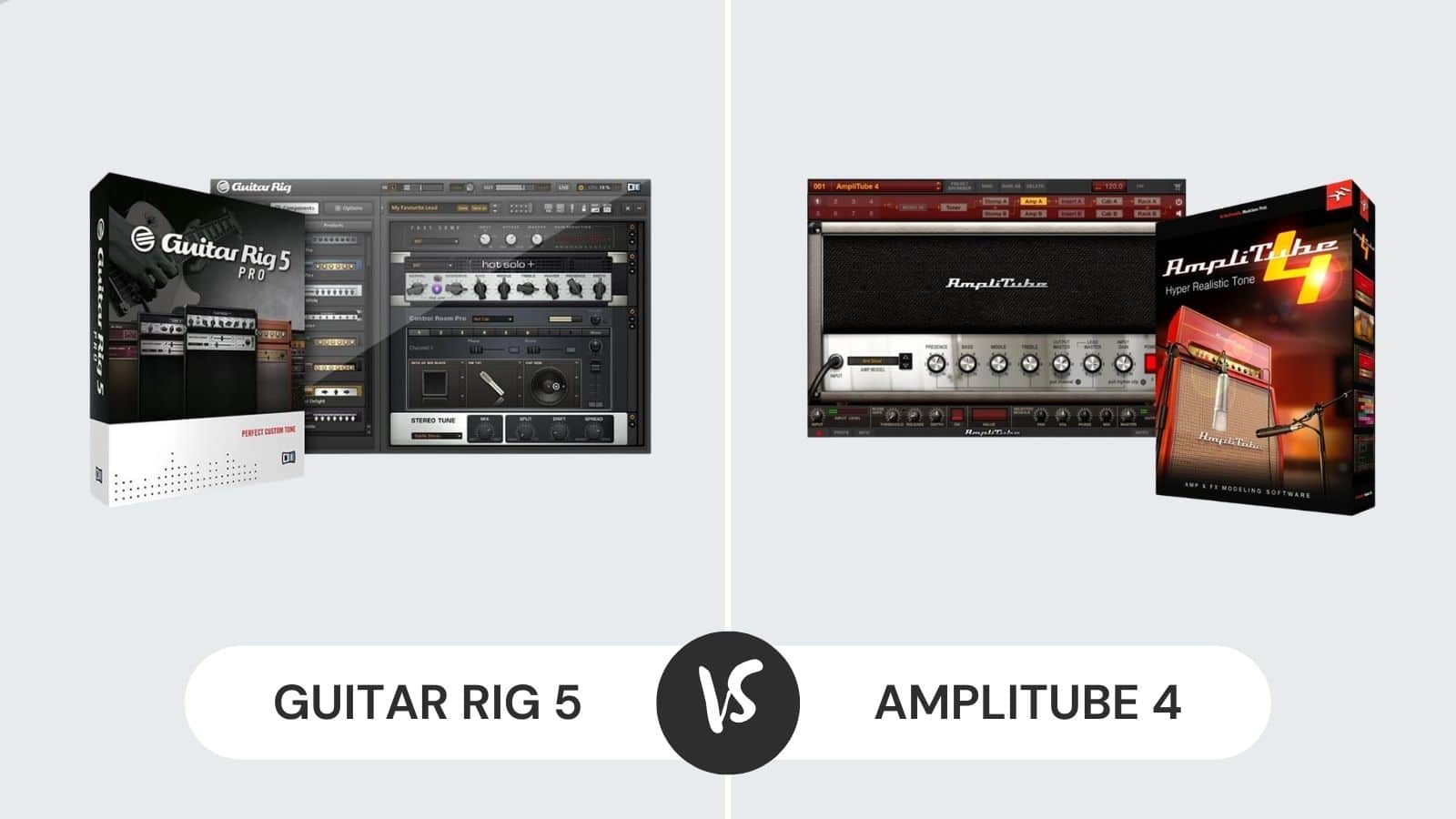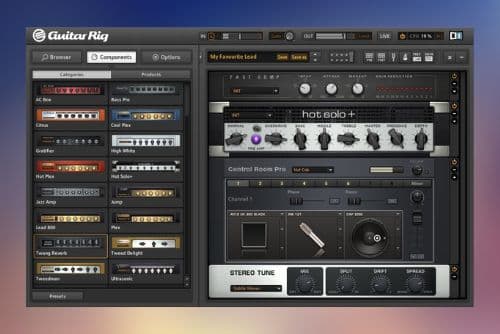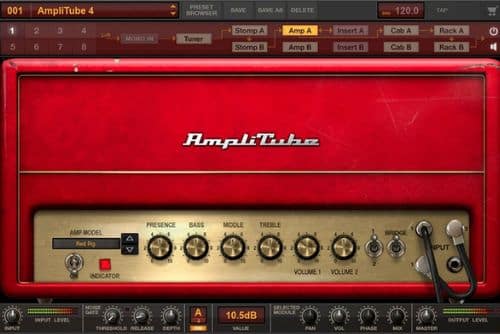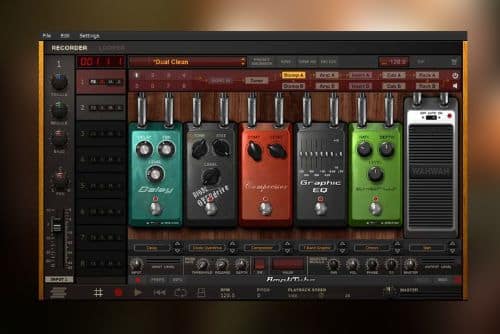
The amp and effects modeling units are essential for musicians to create music with high-end audio quality.
These workstations are designed with high RAM and CPU and advanced effects to create and experiment with audio tracks. Guitar Rig 5 and AmpliTube 4 are two popular multi-effect units with advanced features and native software.
Guitar Rig 5 vs Amplitube 4
| Features | Guitar Rig 5 | AmpliTube 4 |
|---|---|---|
| Converters | 16-bit/24-bit | 64-bits |
| Channels | 2 | 8 |
| Switches | 9 | Not specified |
| Controls | None | Yes, including iRig HD, iRig 2, and iRig Pro |
| Pedals | One expression pedal | Sim pedal |
Guitar Rig 5
Guitar Rig 5 is one of the simplest units with user-friendly features. It allows the users to discover different sounds through amps.
The amps are categorized into guitar and bass, and you can cover different types of audio, ranging from ambient to metal sound. There are multiple presets available, so you can create different sounds from different genres.
It has full-range hardware controls to sync the music instruments and software.
1. Design
The unit is designed with a components section, where you can check out the rig components, including amps, echo, delay, and cabinets. In addition, you can shift the parts to the toolbar directory placed on the top.
It is quite easy to drag the sound element into the rack window, which is placed on the right side. The users can set the dimensions for ports, place the MIDI channels, and create hardware controls for making changes to the interface.
It has a special window where you can connect external hardware devices. It combines the pedalboard controller as well as audio interface with the software, which makes it easy to change the settings.
It can capture every detail of the music performance and add classic heads, effects, mics, and cabs. All of these features are available in the interface, which has a drag-and-drop configuration, so you can select the settings easily.
Guitar Rig 5 can be used in studio and outdoor music performances without compromising on music performance.
It has powerful software that helps create and control the bass and guitar sounds. It can bridge the gap between software and the musician, which means instant response to the music.
In addition, there is a control room with eight well-aligned microphones to your desired cabinet. With multiple components available in each preset, you can add details to the music with the help of a metronome and tuner.
The software is designed to offer 54 effects, 17 amps, 16 mics, and 27 cabinets, which makes it convenient to create detailed audio tracks.
It comes with 130 advanced presets, which include six more effects and two amps. It is a great way of getting rid of elusive sound, promising better audio tracks.
It has extremely user-friendly operations, so you can handle the complex unit setup with extreme ease. For instance, you can drag and drop the cabinets, amp heads, and effects to produce your own rig.
2. Sound
Guitar Rig 5 is a decent option, and the controllers provide better control over the music. Some of the amps create flatter music in the beginning, and the presence controls can be hard to use.
There are Marshal inclusions designed in the unit, which adds grittiness to the track. It can be used to create high-gain music without consuming too much power.
Guitar Rig 5 works pretty well with blues, southern rock, funk, folk, country, and jazz music.
There is a Twang reverb available with which the musicians can riff the music. The amps can catch the touch tones, which helps capture the track’s nuances.
As far as the effects are concerned, delay and modulation pedals are quite engaging and work well, but the tube screamer can be improved.
Every amp is designed with a taxi attribute and control room tools, so you can tweak the built-in unit drivers, mixes, and mic positioning.
Overall, the sounds are highly responsive to touch and sync with the volume control. It’s quite convenient to create clear amp sounds as the spring reverb module is accurate.
Pros
- User-friendly interface
- Controller and hardware are included
- Allows combination and mixing of the elements
- Suitable for basic music genres
Cons
- Slows down the older CPUs
Amplitube 4
This is one of the most advanced amp, effects, and cab modeling units and is a perfect choice for people who like to record guitar sound with a digital device.
The interface has been improved, and there are two new formats available. The brand has improved the effects routing, which allows the musicians to use rack effects as a stompbox – it can be connected to the effects loop or amps.
1. Design
AmpliTube 4 has been designed with cab modeling and represents six live rooms with a 3D visual design.
It has been designed with a new mixer that helps blend two different microphones, pan them, and adjust the width control and room ambiance.
In addition, the users can invert the channel’s phase, so you can work on different guitar tones. In addition, it has a sequencer and a looper, which allows the users to multi-rack the audio tracks.
However, to use the looper, you need a wireless MIDI controller because the spacebar will double up. It’s safe to say that the unit has been designed for tone purists because the modeling is sonic, making it impractical for musicians who like to experiment.
It has its own model, which helps achieve clean funk rhythms and high-gain metal tones because of the humbuckers. It is designed with ten stompboxes, including overdrive, delay, compressor, and chorus.
There are nine amps and ten cabinets available, along with four microphones. There are two tuners and two rack effects units, so you can create clean music with nuanced sound quality.
Every section of the unit allows the users to customize the gear, making it easier to set up the rig.
There are numbered squares on the left side, so you can easily switch between eight routing options. It also has a stereo rig, which allows the users to mix two separate rigs and run effects, amps, and cabs on it.
AmpliTube 4 has a MONO IN option that allows the users to choose the desired stereo input. As far as the pedalboard is concerned, you can drag the pedals in position and make changes to the music tones (it’s a drag-and-drop interface).
As far as the footswitch and knob are concerned, they can be controlled through MIDI – it also helps automate the effects within the DAW plugin. Some pedals are also designed with unique presets, so you can save them.
The amp section is extremely easy to use and allows the users to save the presets. The cab room allows access to the hardware and helps customize the recording sessions as you can set up the cabinets, microphones, and speakers according to the room.
2. Sound
AmpliTube 4 has been designed with a cab room that allows the musicians to customize the speaker selection, cabinet selection, mic placement and selection, mixer selection, and room selection.
Moreover, it has a DAW plugin that provides better control over the features. With the eight-track recorder, you will be able to record and mix around eight tracks at once.
In addition, it has a four-track looper to help you record and loop around four tracks. Moreover, you will be able to import and export the loops and utilize the MIDI foot controller.
The users can connect the stack in a properly simulated environment with various microphones, leading to high-quality sound recordings. All in all, it’s suitable for metal and vintage music, given the extensive range of modern hardware.
Pros
- Exceptional sound quality
- Routing flexibility
- Customizable pedal positioning
- Convenient interface
- Custom shop to pay for the desired effects only
Cons
- Looper is not powerful enough
The Final Verdict
Both Guitar Rig 5 and AmpliTube 4 are great units for people who like to produce music and customize them with the cabs and effects.
However, Guitar Rig 5 is suitable for bass and guitar sounds, including blues, southern rock, funk, folk, country, and jazz music, while AmpliTube 4 is suitable for vintage and metal music.



